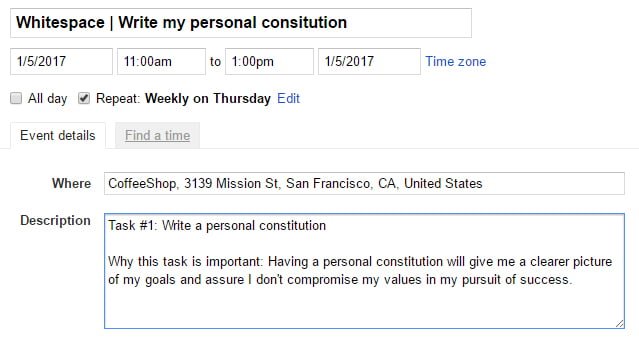
Ever feel like there just isn’t enough time in the day? Like after you finish responding to emails, replying to Slack messages, and sitting in meetings, there’s no time left for the tasks that really matter?
You aren’t alone.
Time management is one of the most universal challenges faced by people across the world; especially entrepreneurs. And it isn’t helped by the fact that our lives are becoming increasingly reaction-driven.
- New email? Gotta respond immediately.
- Slack message? Better get on that right away.
- Meeting request? Can’t turn that down.
It’s easy to spend a whole day on supposedly-urgent, reactive tasks only to get to the end and realize you didn’t actually accomplish anything.
Sure, you responded to 62 emails. But was that really the best form of time management? The most productive? Probably not.
Eventually you’ve got to ask, “Are the things I’m doing moving me closer to my goals, or am I just spinning my wheels?”
Urgent and Reactive vs Important and Proactive Time Management
Take a look at the most successful people you know. How do you think they got where they are?
I’d be willing to bet that, at least in most cases, it wasn’t by responding to every single Slack message within five minutes or attending every single meeting that comes their way.
The most productive people value their time management so much that they own it. Rather than constantly reacting to the urgent, they invest in the important; and instead of spinning their wheels in reactivity, they find massive traction in proactivity.
In the end, it’s only the most productive people–those who take full control over their time management and priorities–who reach their full potential. And here’s the good news: You can do the same. In fact, to meet and exceed your goals, you must do the same. That’s where whitespace time comes in.
Whitespace Time: Leveraging Proactive Time Management To Reach Your Full Potential
Mindmaven’s whitespace approach was built on the fundamental time management problem introduced by Paul Graham’s famous Maker’s Schedule, Manager’s Schedule piece. Haven’t read it? Here’s a quick review of how it relates:
- On the Manager’s Schedule, you’re reactive. Your day is broken into several hour-long chunks, generally occupied by executive tasks like meetings, interviews, or reviews.
- On the Maker’s Schedule, you’re proactive. Your day is broken into longer blocks of time, generally occupied by creative tasks like content production or product development.
Although both schedules are important, the urgency of the Manager’s Schedule often trumps the importance of the Maker’s Schedule [Tweet this!]. As a result, most people spend their days reacting instead of acting.
Whitespace is about reclaiming the Maker’s Schedule and prioritizing proactivity; ensuring you always have time to focus on the tasks that move the needle the most, such as:
- Developing a powerful, motivating vision for your product,
- Connecting with 10 new contacts you feel will be a valuable source of opportunities, or
- Running a roadmap exercise to plan the optimal growth strategy for your company.
You know, the things you’ve been putting off for the past few months until you “find the time.”
But you and I know “more time” isn’t going to just happen. You can’t find time. You have to make time. And more importantly, you have to properly utilize and prioritize that time.
All of this is accomplished in three stages of successful time management: Scheduling whitespace time, getting the most out of that time, and protecting that time at all costs.
Let’s take a closer look at each stage.
Note: This blog article is an accompaniment to our free eBook: Whitespace: An Entrepreneur’s Guide to Proactive Time Management. To get the most out of this article, download the book for free here.
Scheduling Whitespace Time
First things first: Let’s schedule your first whitespace session.
A whitespace session is a weekly block of 3-4 hours built into your calendar that’s completely dedicated to the Maker’s Schedule; allowing you to focus solely on creative problem solving and proactive projects. These sessions should carry the same importance as board meetings.
Here are a few time management pointers to get the ball rolling:
- Avoid scheduling sessions shorter than 2 hours. When you factor in transition time and distractions, it’s easy for an hour-long session to only have 40-45 minutes of peak proactive productivity. Ensure you’re getting your time’s worth by making each session at least 2 hours long.
- Schedule sessions for the peak of your productivity cycle. Schedule your whitespace sessions for the times of day you feel most energized and creative. Early bird? Set your sessions for the morning. Late riser? Aim for afternoon or early evening. Night owl? No problem: Schedule your sessions at night.
- Create a whitespace budget. Decide in advance how much time you want to invest in whitespace each week, then make sure it happens. If it means another meeting or event needs to be canceled or rescheduled, so be it. Always meet that weekly budget.
Action item: Schedule your first whitespace session. Schedule a 3-4-hour block of whitespace time on your calendar sometime within the next seven days.
For more information on scheduling whitespace time, including how to find the best location to avoid distractions, read pages 5 through 11 in our whitespace ebook.
Getting the Most Out of Whitespace Time
Now that you’ve scheduled your first whitespace session, let’s take a look at how to get the most out of it. Here are three time management tips to leverage your sessions for maximum productivity.
- Create a whitespace queue. You should never not know what to work on. Use a task management system like Asana (shown below) to create a prioritized list of proactive tasks. Any time you need a new project, just review the list.

- Set session agendas in advance. Don’t waste precious moments during whitespace trying to figure out what to work on. With the help of the queue above, you should always know the goal(s) of a session before you begin.
- Create a whitespace ritual. Prepping your mind to enter whitespace ensures you’ll get as much out of the time as possible. Create a ritual you run before every session that helps you relax and get excited about the results you’re about to produce. For example, five minutes of box-breathing or meditation might help the mental transition.
Action item: Create your first whitespace session agenda. Go into the calendar event you created for your first action item (you did complete your first action item, right?) and flesh it out with a clear title and a motivational “why.” Here’s how that might look:

For more on utilizing whitespace time, including how to create your own whitespace ritual, read pages 12 through 18 in our whitespace ebook.
Protecting Whitespace Time
Getting something on the calendar was the easy part. Keeping it on the calendar? That’s a different story. Because until you’ve turned whitespace into a habit, it’ll be under constant threat from reactive tendencies.
In the face of urgency, it can be tempting to reschedule or even cancel your sessions. But don’t give in!
Here are three time management strategies to keep that temptation in check.
- Follow the one-reschedule rule. Before you ever schedule something over a whitespace session, ask yourself: “Is this task really more important than whitespace time?” Unless you can answer with a confident “yes,” don’t reschedule. But if you do have to, ensure it only happens once. If you need to reschedule the same session twice or more, you aren’t committed enough to your results.
- Eliminate distractions. Reaching full productivity takes time, and it only takes one distraction to interrupt and reset that time management focus. Ensure you get the most out of your sessions by limiting both physical and digital distractions. For example: Switch off your wifi, put your phone in airplane mode, and wear noise-canceling headphones.
- Debrief your sessions. Most people give up on proactive time management because the results aren’t always immediate or obvious. By logging the results of each session, you can start tracking your results sooner. And any time you feel discouraged, you can review your progress for motivation.
Action item: Debrief your first whitespace session. Log the following information immediately after your first session: The date, length of time, what you worked on, why you worked on it, any necessary notes, and the date/time of your next session.
For more on prioritizing whitespace time, including how to develop a system of accountability and follow-through, read pages 19 through 25 in our whitespace ebook.
Kickstarting Your Whitespace Time Management Habit
Alright, the ball’s in your court now. You’ve got the basics of time management. What are you going to do with them?
Is this going to be another strategy you file away under “Good ideas to try later,” or are you truly committed to making a difference?
If you’re ready for change, create it now: Take control of your time management, be proactive and, if you haven’t already, download our free whitespace ebook to get the most out of this practice.
Good luck out there.



